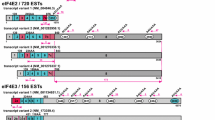Abstract
Interferon regulatory factor 3 (IRF-3) is one of the master transcription factors involved in the stringent regulation of interferon production following virus infection. The aim of our study was to explore new isoforms of IRF-3 and further characterize transcriptional regulation. Two new TSSs of IRF-3 were identified by 5′ RACE experiments. The expression profiles of new isoforms were tested using RT-PCR. Additionally, the promoter activity and potential transcription factor binding sites of the promoter regions were analyzed. Here we report two novel spliced variants of IRF-3 starting from intron 2 of the wild type of IRF-3, Int2V1 and Int2V2. We localized the transcription start sites (TSS) in the second intron of IRF-3 in pheochromocytoma tissue and thus identified two distinct transcripts. RT-PCR results showed they were expressed in most of tissues and cell lines tested. The expressions levels of them are varying in different tissues and cells. Furthermore, Int2V2 were expressed higher than Int2V1 in all tissues. Luciferase analysis in Hela and 293T cell line defined the promoter regions of the new transcripts had higher promoter activities. Both of the relative luciferase activities were over 100 times higher than that of pGL3-Basic vector. Bioinformatics analysis demonstrated that it contains Sp1, GATA-1/2, IRF-1/2 and Lyf-1 transcription factor binding sites in the promoter regions. The discovery of new transcripts of IRF-3 provides a further insight into the alternative splicing of IRF-3. The novel isoforms expanded the splice variants numbers of IRF-3.




Similar content being viewed by others
References
Taniguchi T, Ogasawara K, Takaoka A, Tanaka N (2001) IRF family of transcription factors as regulators of host defense. Annu Rev Immunol 19:623–655
Kanno Y, Levi BZ, Tamura T, Ozato K (2005) Immune cell-specific amplification of interferon signaling by the IRF-4/8-PU.1 complex. J Interf Cytokine Res 25:770–779
Savitsky D, Tamura T, Yanai H, Taniguchi T (2010) Regulation of immunity and oncogenesis by the IRF transcription factor family. Cancer Immunol Immunother 59:489–510
Taro K, Shizuo A (2006) Innate immune recognition of viral infection. Nat Immunol 7:131–137
Mamane Y, Heylbroeck C, Genin P et al (1999) Interferon regulatory factors: the next generation. Gene 237:1–14
Takaoka A, Tamura T, Taniguchi T (2008) Interferon regulatory factor family of transcription factors and regulation of oncogenesis. Cancer Sci 99:467–478
Au WC, Moore PA, Lowther W, Juang YT, Pitha PM (1995) Identification of a member of the interferon regulatory factor family that binds to the interferon-stimulated response element and activates expression of interferon-induced genes. Proc Natl Acad Sci USA 92:11657–11661
Blencowe BJ (2006) Alternative splicing: new insights from global analyses. Cell 126:37–47
Birzele F, Csaba G, Zimmer R (2008) Alternative splicing and protein structure evolution. Nucleic Acids Res 36:550–558
Stetefeld J, Ruegg MA (2005) Structural and functional diversity generated by alternative mRNA splicing. Trends Biochem Sci 30:515–521
Karpova AY, Ronco LV, Howley PM (2001) Functional characterization of interferon regulatory factor 3a (IRF-3a), an alternative splice isoform of IRF-3. Mol Cell Biol 21:4169–4176
Xu HG, Ren W, Lu C, Zhou GP (2010) Characterization of the human IRF-3 promoter and its regulation by the transcription factor E2F1. Mol Biol Rep 37:3073–3080
Nissim-Rafinia M, Kerem B (2002) Splicing regulation as a potential genetic modifier. Trends Genet 18:123–127
Kim TY, Lee KH, Chang S et al (2003) Oncogenic potential of a dominant negative mutant of interferon regulatory factor 3. J Biol Chem 278:15272–15278
Bourdon JC, Fernandes K, Murray-Zmijewski F et al (2005) p53 isoforms can regulate p53 transcriptional activity. Genes Dev 19:2122–2137
Boisclair YR, Brown AL, Casola S, Rechler MM (1993) Three clustered Sp1 sites are required for efficient transcription of the TATA-less promoter of the gene for insulin-like growth factor-binding protein-2 from the rat. J Biol Chem 268:24892–24901
Encinas M, Crowder RJ, Milbrandt J, Johnson EM Jr (2004) Tyrosine 981, a novel ret autophosphorylation site, binds c-Src to mediate neuronal survival. J Biol Chem 279:18262–18269
Jia W, Guo Q (2008) Gene structures and promoter characteristics of interferon regulatory factor 1 (IRF-1), IRF-2 and IRF-7 from snakehead Channa argus. Mol Immunol 45:2419–2428
Book McAlexander M, Yu-Lee LY (2001) Sp1 is required for prolactin activation of the interferon regulatory factor-1 gene. Mol Cell Endocrinol 184:135–141
Orkin SH (1992) GATA-binding transcription factors in hematopoietic cells. Blood 80:575–581
Tsai FY, Keller G, Kuo FC et al (1994) An early haematopoietic defect in mice lacking the transcription factor GATA-2. Nature 371:221–226
Upreti M, Rath PC (2005) Expression and DNA binding activity of the recombinant interferon regulatory factor-1 (IRF-1) of mouse. Mol Biol Rep 32:103–116
Hahm K, Ernst P, Lo K, Kim GS, Turck C, Smale ST (1994) The lymphoid transcription factor LyF-1 is encoded by specific, alternatively spliced mRNAs derived from the Ikaros gene. Mol Cell Biol 14:7111–7123
Matsuyama T, Kimura T, Kitagawa M et al (1993) Targeted disruption of IRF-1 or IRF-2 results in abnormal type I IFN gene induction and aberrant lymphocyte development. Cell 75:83–97
Ogasawara K, Hida S, Azimi N et al (1998) Requirement for IRF-1 in the microenvironment supporting development of natural killer cells. Nature 391:700–703
Acknowledgments
This work was supported by National Natural Science Foundation of China (30570863, 30872804), Natural Science Foundation of Jiangsu Province of China (BK2007244), Medical Academic Key Talent Program of Jiangsu Province in China (RC2007050).
Author information
Authors and Affiliations
Corresponding author
Rights and permissions
About this article
Cite this article
Ren, W., Xu, HG., Lu, C. et al. The characterization of two novel IRF-3 transcripts starting from intron 2 of the wild type of IRF-3. Mol Biol Rep 38, 4415–4421 (2011). https://doi.org/10.1007/s11033-010-0569-1
Received:
Accepted:
Published:
Issue Date:
DOI: https://doi.org/10.1007/s11033-010-0569-1




